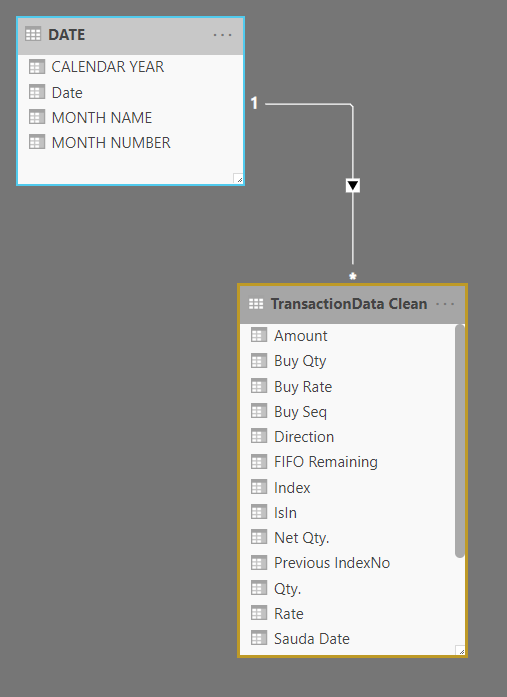Hello - I am trying to implement FIFO in share valuation. I was able to get it in excel, but not able to get the calculation in Power BI.
I have gone through the link on inventory - but could not utilize it for lack of clarity.
I am including the sample data (input and output) as was done in excel - gdrive link (https://drive.google.com/open?id=1vsc8R5MnGy2MVmqxUI7wgHssl6K6wjgM). The blue header columns in FINAL RESULT are the required output - I need help in creating these columns in Power BI - (a) CAPITAL GAIN (b) STOCK IN HAND (c) CLOSING VALUE
Also is the link for the PBX file (https://drive.google.com/open?id=1irJ2vOyV50WdVyYU45YQwA12rkqUNojm), where I am not able to fix the Calculated Column - “Cost Basis with FIFO”. Below is the DAX calculation for FIFO method that I am using - which is not working as per FIFO as it is not picking RATE (the multiplication factor) of the BUY QTY - rather it is picking the current row (SALE RATE), which is not the expected behavior of FIFO.
Cost Basis with FIFO =
VAR myUnits=[Qty.]
VAR PreviousBuys=
FILTER(TransactionData,
[IsIn]=EARLIER([IsIn])&&
[Sauda Date]<EARLIER([Sauda Date])&&
([Net Qty.] > 0)
)
VAR PreviousSales=
SUMX(
FILTER(TransactionData,
[IsIn]=EARLIER([IsIn])&&
[Sauda Date]<EARLIER([Sauda Date])&&
([Net Qty.] < 0)
),
[Qty.]
)
VAR PreviousBuysBalance=
ADDCOLUMNS(
ADDCOLUMNS(
PreviousBuys,
"Cumulative",
SUMX(
FILTER(PreviousBuys,
([Sauda Date]<=EARLIER([Sauda Date]))
),
[Qty.])
),
"Balance Left",
[Qty.]-IF([Cumulative]<PreviousSales,
[Qty.],
VAR PreviousCumulative=[Cumulative]-[Qty.]
RETURN
IF(PreviousSales>PreviousCumulative,PreviousSales-PreviousCumulative)
)
)
VAR CostUsed=
ADDCOLUMNS
(
ADDCOLUMNS
(
PreviousBuysBalance,
"MyCumulatives",
SUMX
(
FILTER(PreviousBuysBalance,
([Sauda Date]<=EARLIER([Sauda Date]))
),
[Balance Left])
),"Balance Used",
IF(
[MyCumulatives]<myUnits,[MyCumulatives],
VAR PreviousCumulatives=[MyCumulatives]-[Balance Left]
RETURN
IF(myUnits>PreviousCumulatives,myUnits-PreviousCumulatives)
)
)
RETURN
IF([Net Qty.] < 0,
([Qty.]*[Rate])-SUMX(CostUsed,([Balance Used]*[Rate])))
FIFO_SampleInput.xlsx (849.2 KB)
FIFO_SampleInput.pbix (378.7 KB)
